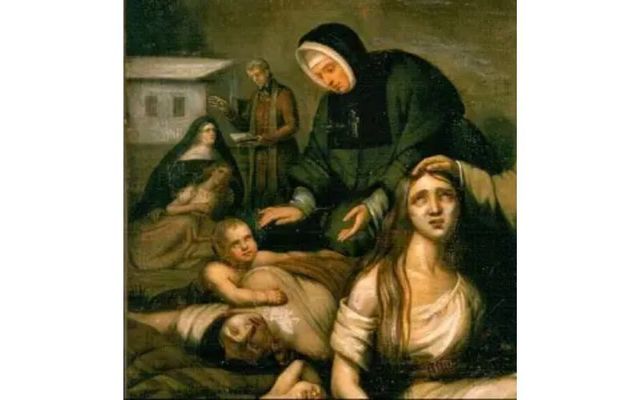At least seven nuns died and many became severely ill as they nursed the Irish and found homes for the 1,500 orphans. At least 6,000 Irish people lost their lives.
When the coffin ships from Ireland began arriving in 1847 there were 50,000 people in Montreal. Over 100,000 Irish, emaciated and often diseased with typhus and other deadly infections, were on their way to Quebec and understandably many Montrealers were afraid. Many wanted the new arrivals pushed into the St. Lawrence River and at one-point Mayor John Mills was forced to deter a mob from doing so.
The immigration depot on Grosse Île near Quebec City was unable to handle the deluge of Irish refugees and as many as 5,000 died there. Another 5,000 – at least – died during the crossing from Ireland. Those Irish who survived were quarantined in the 22 fever sheds, built near where Victoria Bridge now stands.
The Grey Nuns, also known as the Sisters of Charity, were the first order to be called to help the Irish. There were just 40 nuns in the group and most of them became infected with typhus. They carried the sick Irish from the ships to the sheds where they cared for them. At least even Grey Nuns died, but those who recovered from the disease came back and continued to care for those who needed it.
There were 1,500 orphans left after the massive number of deaths. The Nuns found them homes either with other Irish families or French Canadians.
Also among those caring for the Irish were Catholic and Anglican clergymen, and several priests also lost their lives. There are also tales of British soldiers on security detail at the sheds giving up their rations to feed the Irish.
The Nuns' own writings on the disaster are the “most detailed eye-witness accounts of the suffering,” according to the National University of Ireland, Galway, Famine Archives. Their annals have been digitized, transcribed and translated and can now be read online.
The nun's amazing work was also described by John Francis Maguire in “The Irish in America,” in 1868. He wrote:
“First came the Grey Nuns, strong in love and faith; but so malignant was the disease that thirty of their number were stricken down, and thirteen died the death of martyrs. There was no faltering, no holding back; no sooner were the ranks thinned by death than the gaps were quickly filled; and when the Grey Nuns were driven to the last extremity, the Sisters of Providence came to their assistance, and took their place by the side of the dying strangers. But when even their aid did not suffice to meet the emergency, the Sisters of St. Joseph, though cloistered nuns, received the permission of the Bishop to share with their sister religious the hardships and dangers of labor by day and night.”
Jason King, from the National University of Ireland (NUI) Galway, and Christine Kinealy, of Quinnipiac University in Connecticut, put together a portrait of these incredible caregivers for the 2017 exhibition "Saving the Famine Irish: The Grey Nuns and the Great Hunger".

Love Irish history? Share your favorite stories with other history buffs in the IrishCentral History Facebook group.
“The story of the Grey Nuns, and of the other religious orders who helped the dying Irish immigrants, is one of kindness, compassion and true charity,” Kinealy said at the time.
“Nonetheless, almost 6,000 Irish immigrants perished in the fever sheds of Montreal. They had fled from famine in Ireland only to die of fever in Canada. This is a remarkable story that deserves to be better known.”
Fergus Keyes, the Director of the Irish Monument Park Foundation, told the Montreal Gazette, “The exhibit is to concentrate on the people who went to help them, and in many cases gave up their life.
“That included John Mills, the mayor of Montreal at the time, who wasn’t Irish, wasn’t Catholic, but he set up the sheds and went and nursed the Irish and it cost him his life. Sometimes he’s called the Martyr Mayor of Montreal.”
H/T: NUI Galway.
* Originally published in 2016, updated in July 2023.




Comments